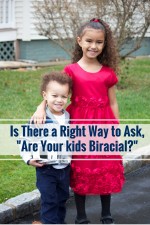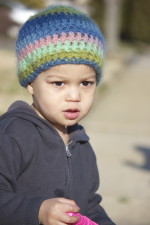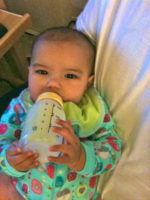Those of you that think kids don’t see color, think again! At three-years-old, Princess started talking about it– differentiating between white and brown grandma. I knew then that there would be plenty of conversations about race, so it was no surprise when she asked about her own skin color. I knew that helping my daughter find her identity is something I needed to do.

“Mommy, is my skin blond?” she asked.
The question caught me completely off guard.
“Do you think your skin is blond?” I asked.
“Yes,” she responded.
“If you’re skin is blond, then what’s my skin color?” I asked.
“You’re dark brown,” she answered.
She then proceeded to say that her Dad is blond and so is her little brother.
I thought that would be the end of our chat. But, she’s also brought up the topic several times since then, leading me to believe that there’s something more to this subject.
She didn’t appear sad or upset. I could tell she was curious and wanted to know why she looks different from everyone else. My hubby and I decided to sit her down to speak with her about it.
Princess’s school is predominately white, and she’s the only biracial child in her class. So, it doesn’t surprise me that she’s already noticing differences among her peers as well as her little brother – who has a lighter complexion.

I asked her if anyone said anything about the color of her skin and she said no, which could only mean one thing – she’s trying to find her identity.
Choosing our words carefully, my hubby and I approached the topic.
“Mommy is black and Daddy is white. That makes you a mix of Mommy and Daddy,” I explained.
We always tell her how beautiful she is everyday. If she ever wants to talk about anything, Princess know that she can come to us no matter what.
Despite the assurance, the reality is that there’s no guarantee that what we say will satisfy her curiosity. I remember being a little girl seeing mostly white women on the cover of magazines and on TV. I wondered why there weren’t girls like me in ads or in prominent TV roles. Seeing someone that resembled me like Rudy Huxtable was a breath of fresh air.
I experienced the same feeling upon entering the field of broadcast journalism. Dark skinned black women were far and few in between. I can totally understand how my daughter feels. Whenever she sees someone with similar features, she gets excited.
“Mommy, look! She has curly hair like me,” she’d point out.
Seeing the response makes me realize the importance of helping my daughter find her biracial identity and teach her important lessons along the way.
Here’s how:
1. Keep an open dialogue. Encouraging questions and having discussions about race satisfies a child’s curiosity. Ignoring the elephant in the room can do more damage than good.
2. Positive reinforcements. I tell Princess she’s smart, beautiful, and talented everyday. Most importantly, I tell her why. Giving positive reinforcements builds self-esteem.
3. Seek out multicultural schools and communities. This has been a challenge for the past few years. It’s difficult to find a great school district in a mixed neighborhood. But, I’ve recently found a school that has a great program and is diverse.
4. Educate. There are some things kids don’t learn in school. It’s up to us as parents to educate our children about their identity.
5. Pray. They say that through prayer anything is possible. We can only do our best, and let God handle the rest. If you’re looking for prayer guidance, check out lapidomedia.com.
How do you help your children find their identity?












I had the SAME ISSUES!!! My mom (who’s white) pulled out a crayon box and used those colors to help us understand what color we were. I was always “tan!” hahaha… 🙂
the fact that you’re even thinking about how best to handle it means you’re ahead of the game! she’ll be fine. probably much better than fine!
I appreciate these tips, especially not to IGNORE the “elephant in the room.” My kids are mixed, but not the definitive “black and white,” and while I’m sure the identity questions are forthcoming…I’m hoping they can simply just “be” for as long as possible!
Hi Stacy-Ann –
I shared via VCB but also shared on my own as it is such an interesting read and education for all of us! I have red hair, born to parents of brown hair, and I always got asked, “where did you get your red hair?” God made us all different and unique to show the world our gifts and strengths. Next stop – following you on social media! Great to connect!
Hugs, Holly
Have a script ready. Kids say what’s on their minds. It’s shocking sometimes.
Thanks so much Nicole! “Better than fine”:)
I am married to an Australian indigenous man and I am caucasian. We have a two year old son and although he has white skin, he will still be faced with questions about his heritage because of his father’s skin colour. This is great advice for me to keep in mind as my son gets older and becomes more aware of the differences between himself, me and his father. Thanks for a great post!
Thanks so much for sharing Kelly.
It’s so nice to know that others have experienced the same things as me! I am 100% Caucasian and my daughters father is 100% African. She is very much a 50/50 split between the two of us and I was totally caught unprepared when she started self-identifying based on her skin and hair at just 3! I didn’t think it would happen until she was older. She started out by saying some very negative things about herself, which also caught me by surprise. And I have found myself becoming quite vocal in expressing to other white-Americans the need for better representation in media and toys as a result.
You are the reason why I blog. In addition to this being a journal for my kids to read some day, I LOVE connecting with parents like you who experience similar things. It pains when to hear anyone speak negatively about themselves. I think it’s awesome that you’ve become vocal for better representation in the media and toys. That is such a huge and important step. THe more we recognize this and aim to change society’s twisted mind set, the more change for the better.